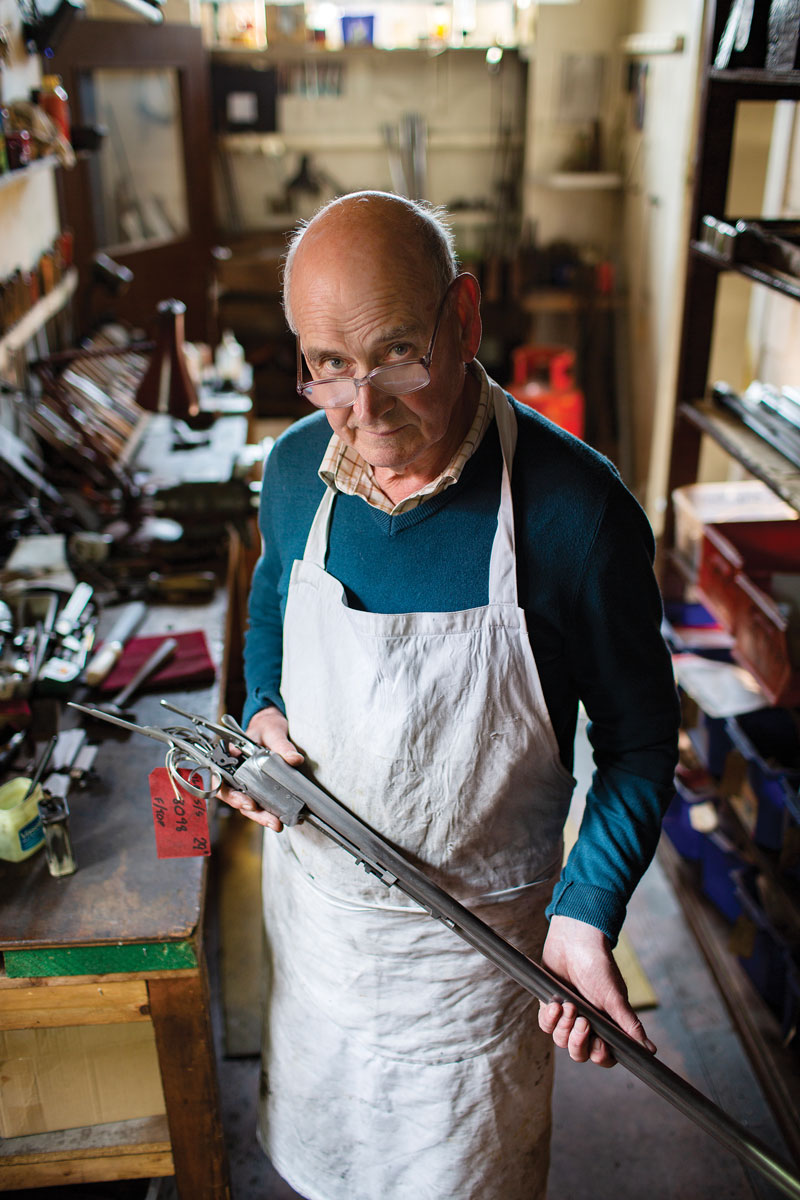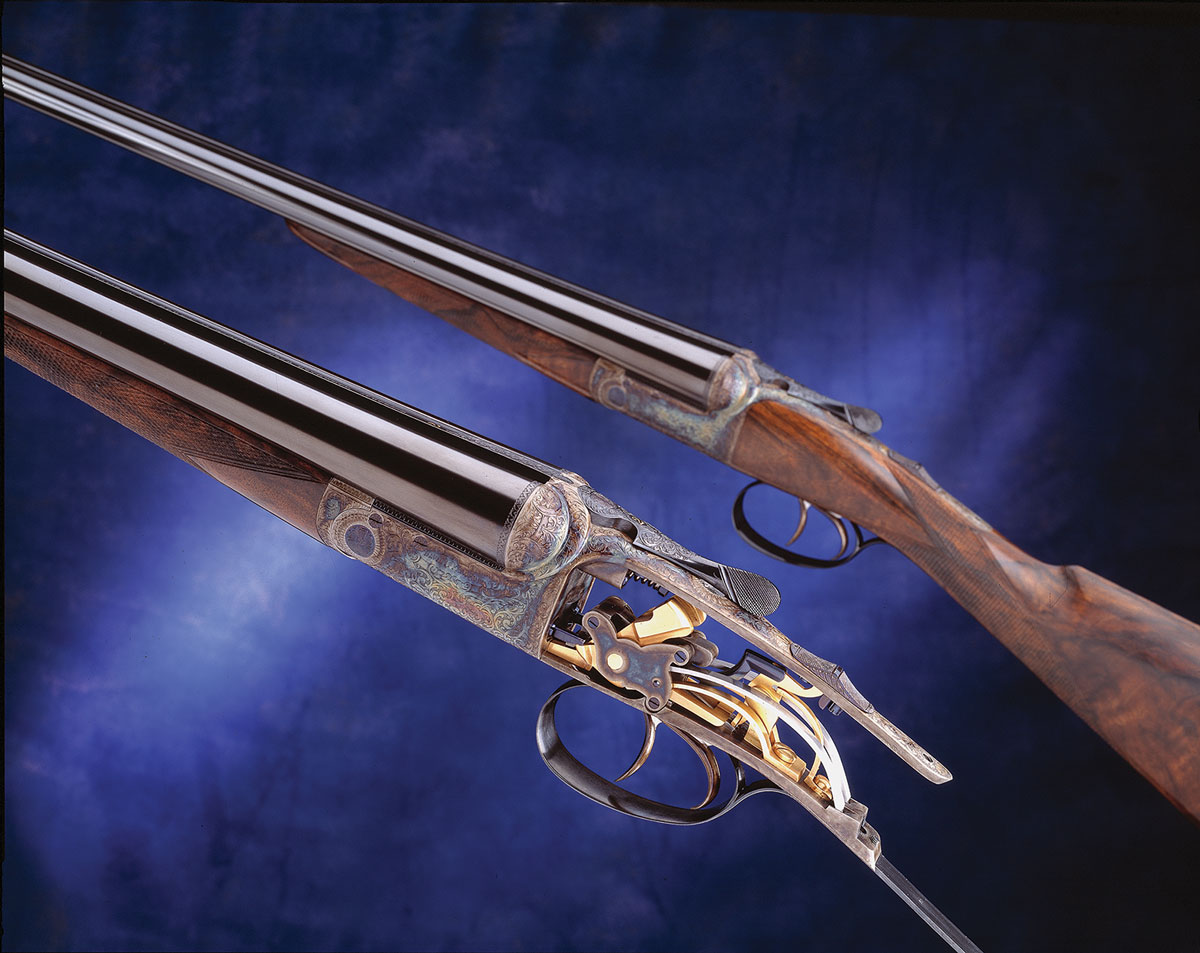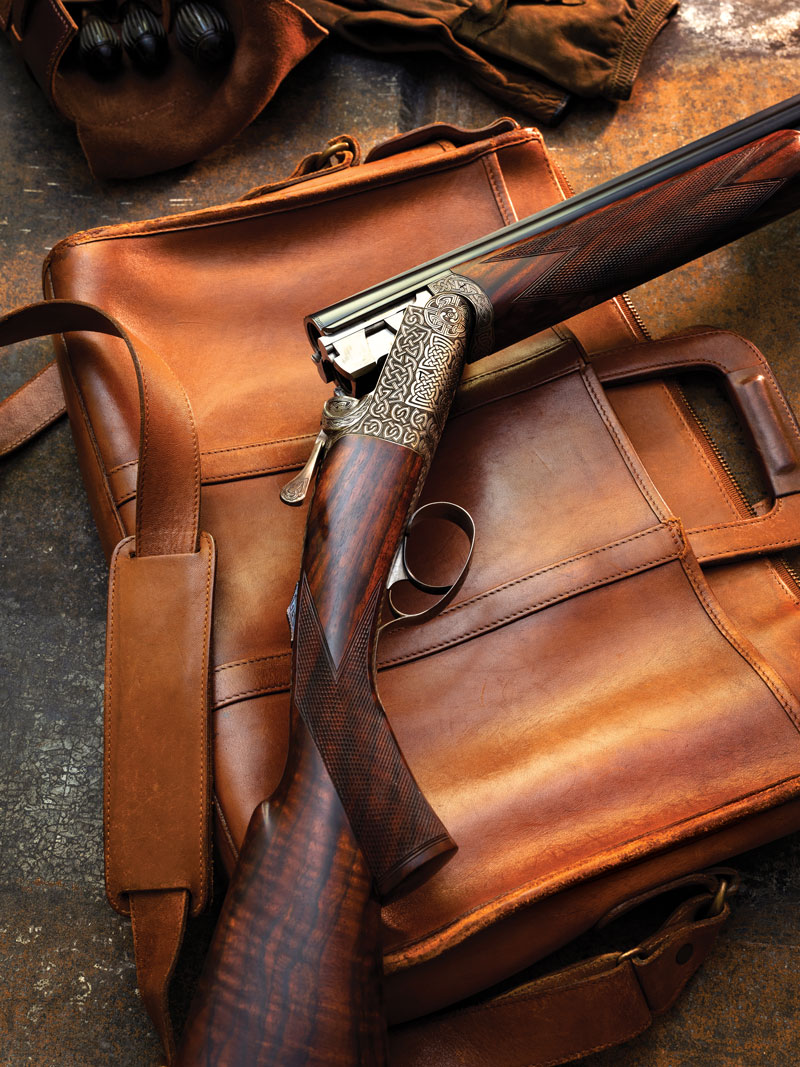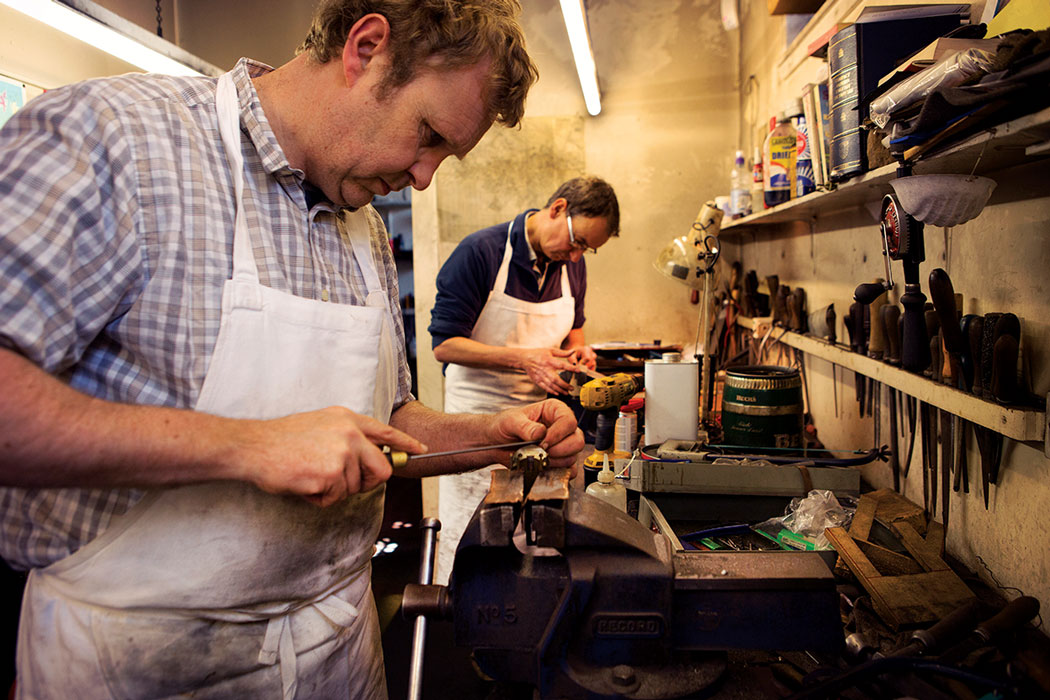
Britain’s most successful independent gunmaker eyes retirement
By Vic Venters
It was 1966, late winter—dreary and gray as late winters in Scotland are—and David McKay Brown was not a happy gunmaker. He was making £16 a week at John Dickson & Son—about $360 today. He’d helped revitalize Dickson’s gun-repair business, and management had promised him a share of the profits. Now they had declined to honor their pledge. David then had asked for a £4 weekly raise, about $90 today. No, he’d been told, he’d have to settle for an extra £2 weekly.
This wouldn’t do. He was 25 and had a young family to support. David hadn’t come up rich, but he was smart and driven—and he had by hard work and passion and study made himself a versatile craftsman capable of mastering virtually every aspect of repairing or building a gun. In a trade where old craftsmen were dying off and young replacements were scarce, those skills, properly applied, could be very valuable indeed.
In March 1967 he left Dickson to set up his own shop near Glasgow. Cash was so tight at first that he drove a cab to pay his bills while he slowly built his business, most of it based on repair work for the British trade—and much of that for his former employer.

On his own, as he worked on guns for others, he dreamed of resurrecting Scotland’s most famous sporting gun: Dickson’s elegant “Edinburgh,” or the Scottish Round Action, which had been out of production for years.
The Round Action, built to a proprietary triggerplate design, was made as a best gun and priced accordingly. To build to such standards always had required a team of highly skilled gunmakers using special tools, jigs and fixtures. It took David more than four years to tool up and painstakingly make his first Round Action, in 1974—mostly alone with hand tools and a single small vertical milling machine that cost £500. Engraved by Malcolm Appleby, it was faithful to the original design, patented and perfected in the 1880s, and it was just as beautiful. The influential British gunwriter Geoffrey Boothroyd described it as “an aristocrat amongst shotgun actions” and praised David’s accomplishment in a 1976 article in Shooting Times & Country Magazine. David said this caught the eye of Alistair Sinclair, Dickson’s managing director. At the time, repair work for Dickson still provided David’s main source of income. “After he examined my gun closely,” David said, “he requested I build them six guns a year to be sold as Dicksons.”
The British venerate old established gunmaking names as a Crusader might the True Cross, and David’s name carried none of the treasured patina of history. He had, in the class-riven language of the day, no “pedigree.” It made sense to build Round Actions for Dickson to rebadge as its own.
After spending two years building it, David delivered a first Round Action to Dickson, and then the following year a pair. “But they refused to pay me the normal deposit for the other guns under construction,” he said. “When I told them I’d have to sell them under my own name, the managing director laughed and said it would be impossible without Dickson’s name.”
But Dickson reckoned wrongly when it threw down the gauntlet. As Sir Walter Scott famously wrote: “I am a Scotsman; therefore I had to fight my way into the world.” David placed an advert in Shooting Times. “I took an order for a set of three plus a pair,” he said. “This was brought to the attention of their lawyers, but the patents had expired at the end of the 19th Century. I then declined their repair work, including fitting in new barrels, which they were keen for me to continue with. All this terminated our relationship.”
David McKay Brown Gunmaker—as he had named his business—had come into its own.
This past July David turned 79. Sixty-three of those years have been spent at the bench, 53 of them working for himself. For 46 years he has built bespoke best-quality Round Action guns and rifles under his own name—as of this writing, 780 to be exact. For an independent British gun manufacturer of this generation, building almost 800 bespoke best-quality guns has no precedent. It not only has made him prosperous, but also has earned him near-universal respect of peers and competitors. According to Anthony “Trigger” Alborough-Tregear, Managing Director of Westley Richards: “In modern terms, judged by the last half-century, David will go down as one of the greatest British gunmakers in history. Every problem he has encountered in his career he has methodically studied and overcome.”
And next July, when David finishes up the 15 guns currently in process, his singular career will come to an end. He has retirement in mind and is seeking a buyer for his business. “I have always intended to retire when I turned 80,” he said. He is no longer accepting orders.
It will be the end of an era—but what an era.

The son of an electrician, David grew up mad-keen about guns and rifles—plinking, shooting game with them, learning how they worked and fixing them. With his dad (“a skilled poacher”), he’d put meat on the table by taking rabbits and grouse from estates near his home in the coal-mining country east of Glasgow.
As a student, he excelled in math, physics and engineering, and to the latter discipline his first job followed at age 16, when he started as an apprentice draftsman at a heavy-engineering firm. At night he attended engineering classes at a local technical college. But the gun bug had left its mark, and—to his family’s initial dismay—in 1958 he left a promising career in industry to become an apprentice gunmaker at Alexander Martin, in Glasgow.
Traditional gunmaking in post-Second World War Scotland was moribund. The national economy—built on heavy industry, shipbuilding, steel and coal—once had been the pride of Britain’s Industrial Revolution, but its best days were past. Unlike West End London firms, Scottish gunmakers like Martin had no export market. One by one, Scotland’s smaller makers were absorbed by the best and strongest and finally the last one standing: John Dickson & Son. In 1960 David came aboard Dickson, when it purchased Martin. Although production of Dickson’s Round Action was drawing to a close, there remained a few old hands in the Edinburgh workshop who taught the inquisitive apprentice of its working and manufacture. In the model’s late 19th and early 20th Century heyday, it mostly sold domestically to Scottish gentry and industrialists; however, David sensed that a new version could have broader appeal.
But to resurrect Round Actions on a commercial basis—that is, to make enough of them and at a profit—he needed craftsmen to assist him. In the 1970s and ’80s there still were talented outworkers who could help build boxlocks and sidelocks, but none had experience building Round Actions. So David trained his own team: Doug Proctor, lockmaker; Jim McDonald, barrel filer; Brian Sinclair, stocker; and Robin Moir, actioner. They have been with him since and have been essential to the company’s success. David’s wife, Alexe, became the firm’s accountant and business manager.
Michael Louca, a Purdey-trained gunmaker and owner of London’s Watson Bros., made barrels for some of David’s early guns and credits David for inspiring his own business model: to remain independent (no outside owners) and to use outworkers only when necessary. “When you own your business,” Michael said, “you can run rings around the bigger firms with corporate owners. Training your own workforce and keeping manufacturing in-house decreases costs, boosts profits, improves efficiency and quality control, and fosters innovation.”
He added: “David is one of the few people in the gun trade I can have a conversation with about every aspect of a gun and its entire manufacturing process.”
Ultimately, though, to build a successful business David needed a product with broad international appeal—and in a gun of his design he created just that: the McKay Brown Round Action over/under, the first of which was completed in 1992. It harnessed the Round Action’s ultra-reliable triggerplate locks with Woodward-type barrel hinges and Boss-type action buttresses, but it dispensed entirely with the often-fussy ejectors of older British O/U designs. The Scots are renowned for their practicality, and for ejectors David chose the competition-proven coil-spring design of Perazzi.

David’s influence beyond the narrow halls of bespoke gunmaking is clear.
Photographed by Terry Allen
To the mechanics, David married the aesthetics of the Round Action—its rakish toplever, the curvaceous style and shape of the fences and top strap, and a low-profile rounded action that was lightweight but strong. It was purpose built to handle like one of his bespoke side-by-sides.
When David officially registered the design of his over/under, it was the first new Scottish shotgun design in more than a century. By the early 1990s, game shooters everywhere were turning from side-by-sides to over/unders, and for those who wanted best-quality British iterations David felt his was a London-sidelock-beater. “I was very confident it would sell against best London over/unders, which I had repaired and serviced over the years,” he said. “I knew their weaknesses.”
And sell it did. By the time David wraps up business, 394 will have been made, or 51 percent of his total production. For the past several years, 80 percent of gun orders have been for over/unders. “My over/under saved my business,” David said. “I’m not sure it would have survived with the side-by-side alone.”
But selling and making are different things, and initially, building over/unders was a problem. The first five were made with conventional machining and traditional handwork. “I realized I had to go over to CNC for component manufacture,” David said, “otherwise the manufacturing costs would have been prohibitive, profits nil and production times extended.” To overcome the challenge of building a best-quality gun with a profit margin, David’s training in engineering came to the rescue in two related-but-separate spheres: the practical and the philosophical.
To the latter point, Westley Richards’ Alborough-Tregear explained: “David took a hard-nosed look at gunmaking as a manufacturing process—without all the romantic bull-shite that writers like you spew out. Craftsmen often look at the machine shop as an imposition on their skills, a threat. Engineers do not, and David never did. He thought, Machines are my friends. He regarded hand-craft and the machine as a symbiosis—and a symbiosis he could use to build a highly successful business.”
Given low-volume production in bespoke gunmaking, David couldn’t afford to fit up his own machine shop with CAD, EDM and CNC machinery, but as a trained draftsman he could supply local machine shops—some among the best in the world—with hard-copy technical drawings.
However, David wasn’t happy with half-measures. He enrolled in a technical college to learn CAD and became so proficient that he eventually could supply digital files to his CNC subcontractors. He has used those skills to continually tweak the O/U and has made more than 30 improvements to date.

As a result, his craftsmen have better, more-accurately made components with which to ply their handwork when building out the guns. His ability to produce guns relatively quickly—from order to delivery in about 12 months—is the envy of the British gun trade. In his best years, 2004 and ’05, he made 36 guns in each.
When bottlenecks with British engravers became a problem, David turned to Creative Art, in Gardone, Val Trompia, a studio of eight Italian engravers conversant in many styles who work quickly with great skill.
North America has more inhabitants of Scottish ancestry than Scotland itself, and when the double-gun frenzy swept America in the late 1980s and ’90s, affluent shooters fell in love with McKay Brown side-by-sides and over/unders. “I cannot deny that a gun made in Scotland has a certain attraction to many Americans,” David said. He advertised in America’s fine-gun press, hosted shooters in Scotland and attended exhibitions abroad. More than 53 percent of his total production has gone to America, and in the past decade his orders have skewed heavily to the US.
David’s success would not have been possible had his guns not worked—and kept working even after heavy use. One American, a crack shot and influential fine-gun collector, has garnered David more than 60 orders, mostly over/unders, based on his “passionate” recommendations to friends. His first best gun was a 28-gauge McKay Brown O/U, which he has shot hard for nearly two decades—from the high-volume dove fields of Argentina to hunting ducks and geese with loads it probably wasn’t designed to digest. “It has never failed me,” he said. “It is a saber, sleek and rounded, and possesses the most confidence-inspiring handling dynamics. It has been completely reliable. If I had only one best gun to own, this would be it.”

The transnational appeal of the Round Action over/under hasn’t escaped the attention of high-volume gunmakers, some of whom have paid homage to its shape if not its internal mechanism. From B. Rizzini to Caesar Guerini to Connecticut Shotgun’s Inverness, David’s influence beyond the narrow halls of bespoke gunmaking is clear.
David said he is “flattered” by this attention, but the greatest compliment has come from the shooting public—in America certainly—where the Scottish Round Action is today better known as the McKay Brown Round Action. Jean-Pierre “J-P” Daeschler, a working craftsman and the current managing director of John Dickson & Son, is gracious in his praise. “No gunmaker, past or present, will ever emulate the success David has had over the last 45 years,” he said. “He is one of the last gunmakers whose guns actually carry the name of the man who built them. He is also a gunmaker in every sense and a businessman, taking a handcrafted product from Scotland and finding a larger market for it: the United States. I have the utmost respect for what he has accomplished.”
Pedigree comes from how you make it.
Thanks to gunmakers Michael Louca, Anthony Alborough-Tregear and J-P Daeschler for their perspectives and to author Donald Dallas, whose book David McKay Brown: Scotland’s Gun and Rifle Manufacturer (available from donalddallas.com) is the definitive source on David’s career.
Read our Newsletter
Stay connected to the best of wingshooting & fine guns with additional free content, special offers and promotions.






